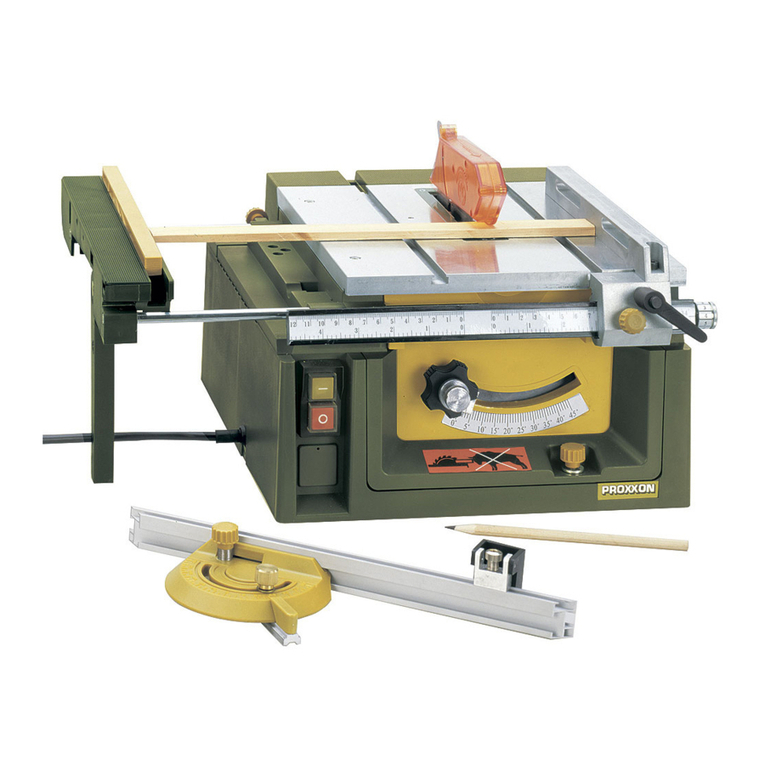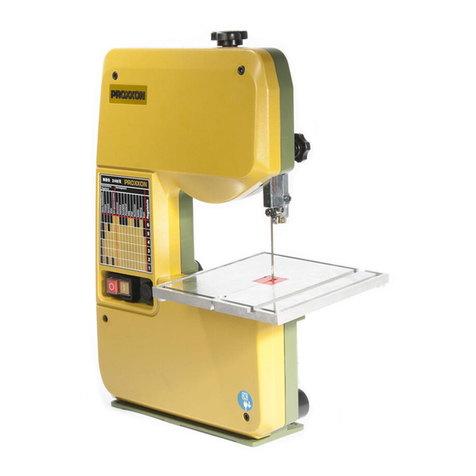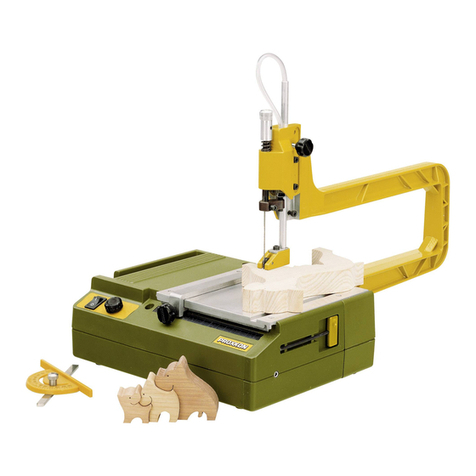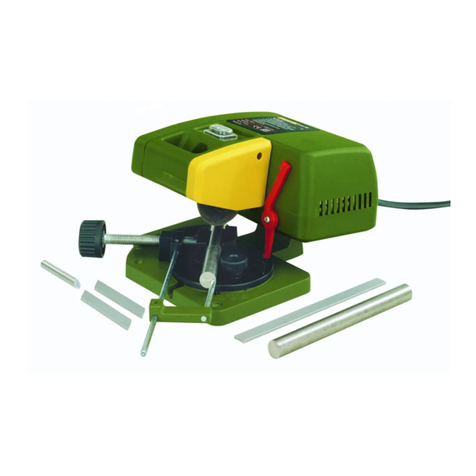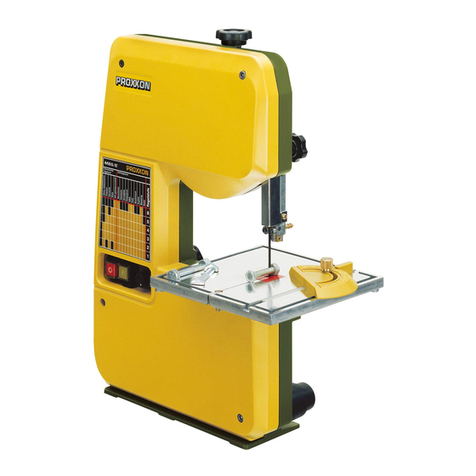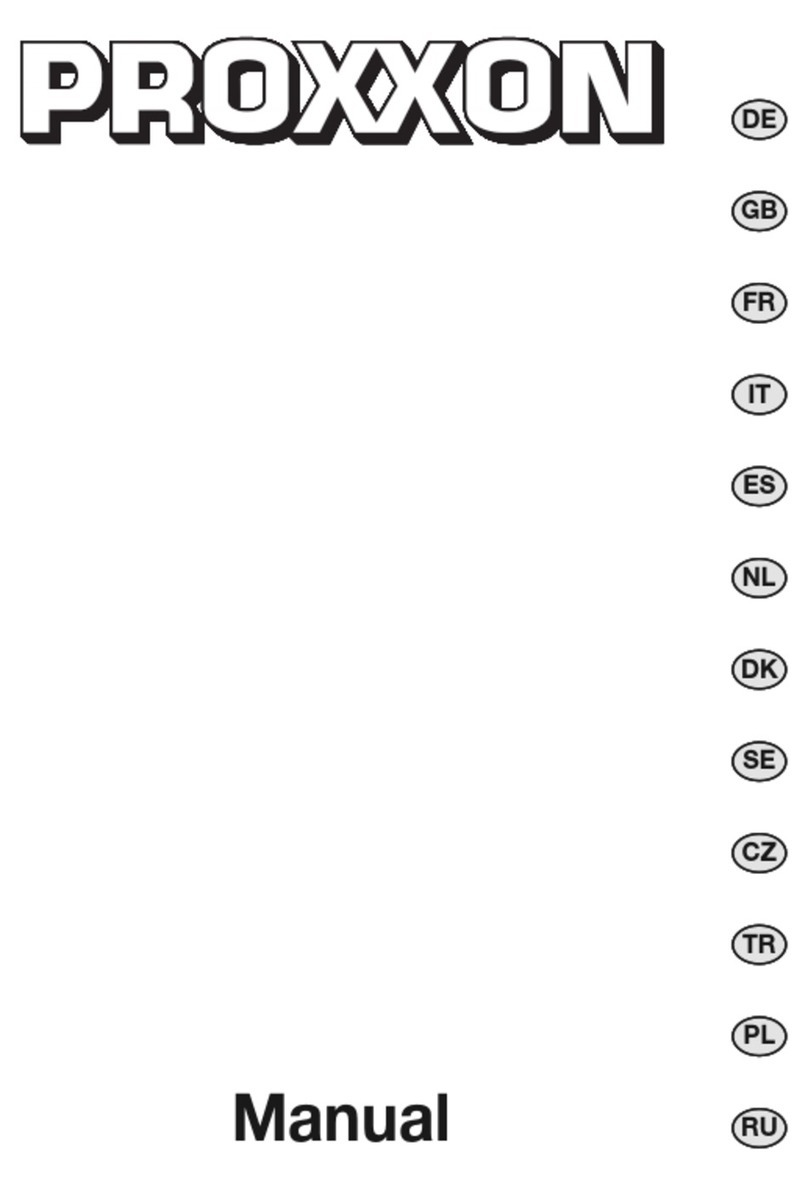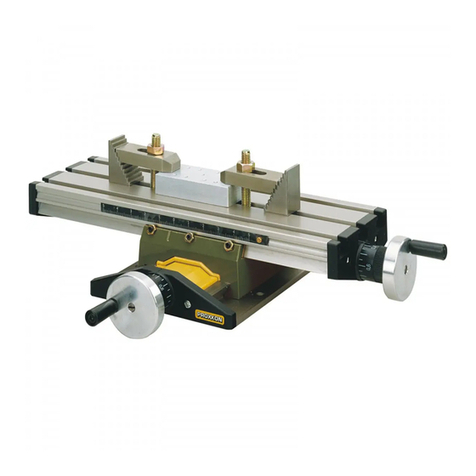not want to do without the more accurate guiding of the blades with flat
ends (unlike those with pin ends) but do not want their disadvantages.
There is no lateral twisting in the attachment yet the blades can still fol-
low the up and down movements of the saw arms freely without being
exposed to bending forces.
1. Place the sliding blocks 1 (fig. 7a) in the openings provided in the
saw table 2. The right clamping length is defined immediately. Cau-
tion: The clamping nuts 3 must be loosened and facing upwards!
The sliding blocks must be inserted so that the pointed ends are
facing each other, i.e. inwards.
2. Insert the saw blade in the centre of the clamping slit and tighten
the clamping nuts with the Allen key 5 provided. Caution: The saw
blade must be inserted the same distance into the clamping slit on
both sliding blocks.
3. Push back the saw table 2 as described above and fold away the
saw blade guard 6 if necessary.
4. Turn the knob 7 to the left to loosen the tension on the saw blade.
5. Remove the saw blade if necessary and insert a new saw blade 4
with the sliding blocks into the saw blade holders as shown in fig.
7b. Slight pressure can be applied to the top arm as required or the
blade tension can be loosened further on the knob 7 if necessary.
Caution: The teeth of the blade must face downwards!
6. Pull the table forward again as described above.
7. Regulate the saw blade tension as described in the section “Fine
Setting of the Correct Saw Tension”.
6.6.2 Swa Blades with Pin Ends (Fig. 8):
Saw blades with pin ends are very suitable for working with many
closed inside cuts. Here, the saw blade can be taken quickly and con-
veniently out of the top holder, looped through the workpiece and reat-
tached. Details can be found in the “Inside Cuts” section. But be
carefully: The precision of the guiding with pin end blades is inferior to
that of saw blades with flat ends and sliding blocks. Absolute precision
in the guiding of the cut can only be achieved with these.
1. Push back the saw table 1 as described above and fold away the
saw blade guard 2 if necessary.
2. Turn the knob 3 to the left to loosen the tension on the saw blade.
3. Remove a saw blade already in the holder and fit the saw blade 4
with the teeth facing downwards into the bottom holder 5.
4. Press the top arm 6 lightly if necessary and attach a new saw blade
to the top holder 7. Loosen the saw blade tension further with the
knob 3 if necessary.
5. Release the arm after attaching the blade and set the blade tension
with the knob 3.
6. Regulate the saw blade tension as described in the section “Fine
Setting of the Correct Saw Tension”.
6.6.3 Fine Setting of the Correct Saw Tension (Fig. 9):
The right saw tension is decisive for a good work result. It must there-
fore be set carefully. The saw blade can also break if it is too tight or
too slack.
Please turn the knob 1 (fig. 9) to set the tension. The saw blade is
tightened by turning the knob to the right (clockwise) and loosened by
turning it to the left (anticlockwise).
A correctly tensioned blade emits a high tone when “plucked”.
7Working with the Saw:
7.1 General Information for Working with the Scroll Saw
The scroll saw is primarily a machine for sawing curves and precise
cut-outs. A typical application is shown in fig. 10. The operator must
move the workpiece carefully for this. N.B.: Scroll saws are usually
operated without a longitudinal stop because the saw blade “wanders”
when it is guided “by force” against a stop, especially in the grain of
wood.
Please note that the saw blade only saws in the downward movement
in the direction in which the teeth are facing.
For good results, please note the following points:
•Press the workpiece against the worktop when sawing; guide gently
with little force; more pressure on the worktop, less pressure on the
saw blade.
•Make sure that the workpiece is lying firmly on the saw table (no burr
or chips).
•Adapt the movement to the requirements of the saw blade, speed
and material of the workpiece.
•Move the workpiece into the saw blade slowly especially if the blade
is very thin and the teeth very fine or the workpiece is very thick.
N.B.: The teeth only saw in the downward movement!
•Only use perfect saw blades!
•Do not leave the device unattended!
•Draw/mark the guide line carefully.
•Provide good lighting conditions!
•Always work with connected dust exhaust and align the air nozzle
carefully (see also “Assembling the Air Nozzle”).
•The best results are achieved with a wood thickness of less than 25
mm.
•For wood thicknesses greater than 25 mm, you have to guide the
workpiece very carefully to avoid jamming, bending, twisting and
snapping of the saw blade.
•For exact cuts in wood please bear in mind that the saw blade will
always try to follow the grain (applies especially for thin saw blades).
•When sawing round materials, please bear in mind that these could
turn with the movement of the saw band and therefore must be held
particularly tightly! Please use a suitable holding device for the work-
piece if necessary!
7.1.1 Choice of Saw Blade
As already mentioned, the right choice of blade for the material has a
great influence on the quality of the result. The table below serves for
orientation. Of course, a wide experience with many different types of
materials and saw blades is always helpful, too. It is worth experiment-
ing a little!
A tip: The saw blades are usually only heavily worn in the place where
the teeth are most stressed and therefore get blunt quickly. To “use up”
the teeth which are not worn and thus prolong the life of the saw
blades, the contact surface for the workpiece can be “raised” slightly
artificially.
Simply fix a smooth underlay of the appropriate thickness and same
size of the table to the saw table with double-sided adhesive tape for
example. The parts of the saw blade which are not worn now saw into
the workpiece.
This is particularly useful when sawing very hard and therefore very
wearing materials frequently with fine blades.
The figures for characterising the “fineness” of the teeth refer to the
number of teeth per inch of the saw blade length:
Round saw blades (with flat ends) are ideal for use with plastic, hard
and soft wood. They cut on all sides so there is no need to turn the
workpiece when sawing.
Our full range of suitable saw blades for your DS 460 can be found in
our Micromot catalogue or on the Internet under www.proxxon.com.
Teeth/inch Material:
approx. 10-14 soft and hard wood (approx. 6- 50 mm),
plastics, softer materials, thicker work-
pieces
approx. 17-18 finer sawing work, wood (up to approx.
6 mm), plastics, softer materials, thinner
workpieces
approx. 25-28 plastic, GRP, non-ferrous metal, plexiglass,
iron, FR-2 with restrictions
approx. 41 iron, FR-2
15

